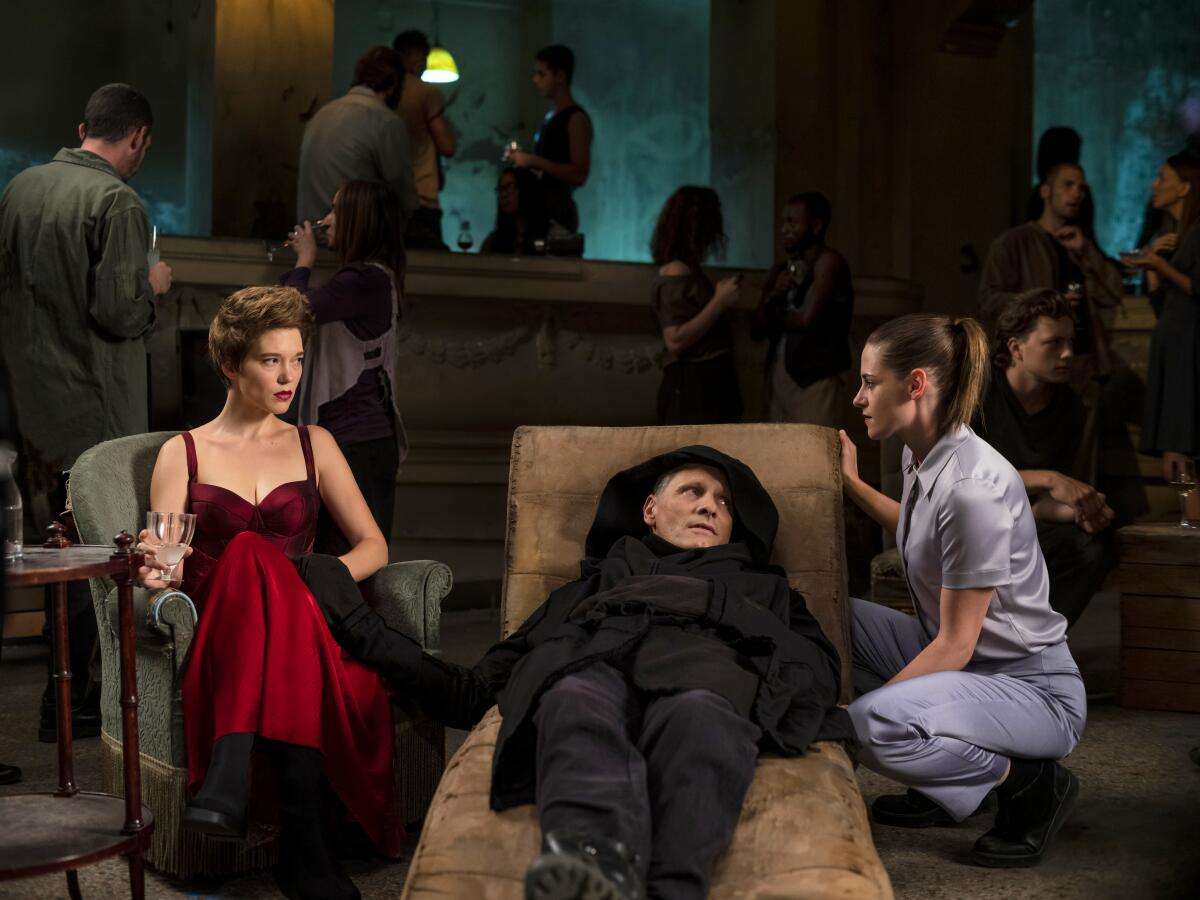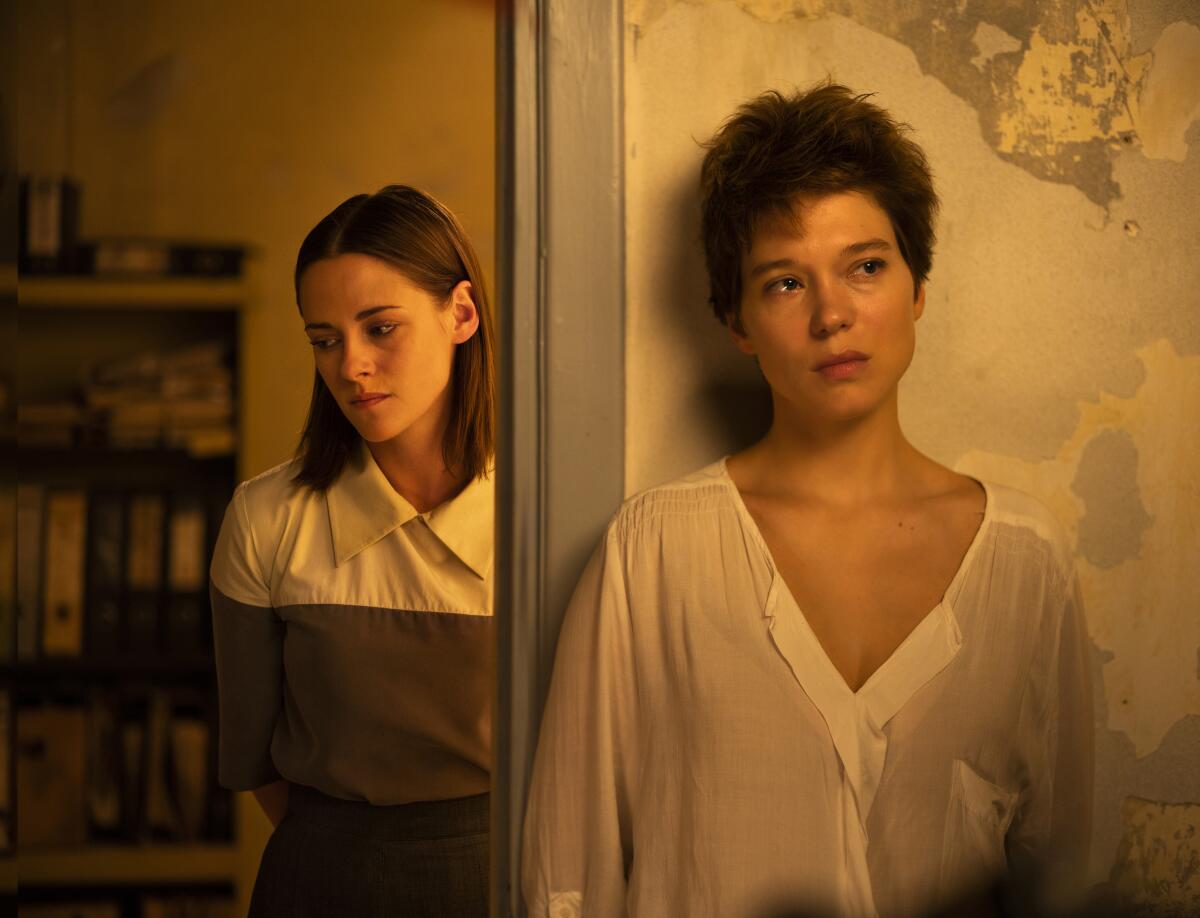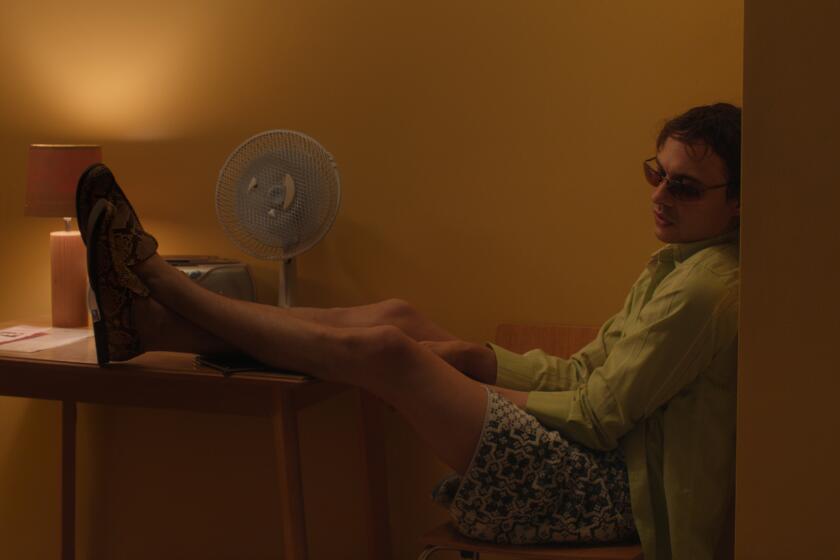Surgery, sex and superfluous human organs converge in David Cronenberg’s ‘Crimes of the Future’

- Share via
Early on in David Cronenberg’s “Crimes of the Future,” a speculative horror-comedy as wildly deranged as it is beautifully controlled, we witness a live demonstration that functions as an art show, a medical procedure and a very public seduction. The nearly naked man encased in the large, mechanized sarcophagus is Saul Tenser (Viggo Mortensen), who has willingly turned his body into a living, breathing, lightly bleeding fresco. The woman working deftly on his insides is Caprice (Léa Seydoux), though instead of scrubs she wears a thin-strapped evening gown, and she uses what looks like a rubbery video-game console to control the scalpels that will slice her partner open.
Saul, his eyes closed and his mouth slightly open, takes intense pleasure in these probing, penetrative sensations. Caprice clearly does as well, breathing heavily as she presses the console against her body and fingers the controls. Whether you savor the sensuality of this sequence or recoil from its grotesquerie (or both), you understand, on a visceral as well as intellectual level, what’s going on. So much so that it’s a little redundant, if amusing, when a mousy onlooker named Timlin (Kristen Stewart) pops up in the next scene to declare, “Surgery is the new sex.”
For your safety
The Times is committed to reviewing theatrical film releases during the COVID-19 pandemic. Because moviegoing carries risks during this time, we remind readers to follow health and safety guidelines as outlined by the CDC and local health officials.
All of which may provoke two distinct thoughts: First, why isn’t this called “Crimes of the Suture”? And second, it’s marvelous to have Cronenberg back and to behold his undimmed, unparalleled skill at welding the formulations of horror and science fiction to the cinema of ideas. Eight years have passed since his previous feature, the scabrous Hollywood takedown “Maps to the Stars,” and “Crimes of the Future” suggests an amusing, halfway plausible explanation for why it took him so long to emerge from a rumored early retirement.
The official narrative is that Cronenberg dusted off and revised a decades-old script. Maybe so, or maybe he really did travel to some not-so-distant future dystopia, from which he has now returned with a prophecy and a warning. Bearing no narrative relation to Cronenberg’s 1970 independent feature of the same title, this “Crimes of the Future” is a feverishly imagined dispatch from a world where weird names abound, environmental catastrophe looms and the human body is mutating with alarming, unprecedented speed. No obvious pandemic metaphors loom here, even if Saul does spend much of his time outdoors in a face mask that matches his dark hooded robes.
In an eerily depopulated world where physical pain has dramatically decreased, leaving individuals free to cut open their own bodies for pleasure and profit, Saul is both an outlier and an exemplar. His own body is frail, weak and plagued by chronic agony, the effects of which he tries to dull with automated home-care equipment — a torturous-looking chair that aids with eating and digestion, a veiny, midair-suspended bed stolen from H.R. Giger’s boudoir — that’s engineered to anticipate and eliminate every discomfort. And that discomfort may be tied to his body’s unusual ability to synthesize new organs, essentially a form of metastatic cancer that Caprice and her scalpels keep routinely in check.
Mortensen, such a muscled, brutish pillar of strength in Cronenberg’s “A History of Violence” and “Eastern Promises,” is all the more poignant here with his lumbering gait and rasping-and-coughing vulnerability. He and Seydoux have a moving rapport that carries a whisper of high-toned kink: Caprice may be a doctor attending to her patient and a dominant toying with her submissive, but most of all, she sees herself as an artist perfecting her canvas.
“How can a tumorous growth be considered art?” someone asks, and the answer goes beyond the dark tattoos that Caprice etches on Saul’s superfluous organs. In removing them from his system, she disrupts the natural flow of human entropy, extracting hope, inspiration and even meaning from the body’s inner chaos.

And whatever else it may be — a blood-spattered neo-noir, a parable of environmental decay, an uncommonly bizarre and tender love story — “Crimes of the Future” also operates as a deadpan satire of the modern art world. Seldom has the natural tendency of artists to mine themselves for creative material been pushed to such exquisitely yucky extremes.
Saul and Caprice are an avant-garde power couple, and their all-consuming commitment to their work has earned them no shortage of loyal fans, showily self-mutilating rivals and awestruck groupies. Two of the latter are Timlin and her boss, Wippet (Don McKellar), who work for a clandestine government branch tasked with officially registering each new organ that appears, in hopes of reversing their grim diagnosis that “human evolution is going wrong.”
If Mortensen and Seydoux are entirely convincing as skilled and self-demanding artists — since that’s exactly what they are in real life — then Stewart is hilariously cast against starry type. Her Timlin is a squeaky-voiced pedant whose awkwardness masks personal and professional ambitions, as well as a lust for Saul that briefly threatens to transform “Crimes of the Future” into a triangle. Also caught up in the noirish mix are a nosy detective (Welket Bengué), two tech-savvy femmes fatales (Tanaya Beatty and Nadia Litz) and a combative former couple (Scott Speedman and Lihi Kornowski) whose 8-year-old son has evolved the curious ability to eat and process plastic, something he manages by spewing a corrosive digestive fluid.
That last bit may be a nod to Cronenberg’s splattery 1986 masterpiece, “The Fly,” even as “Crimes of the Future,” with its graphic, symbiotic twistings of flesh and machinery, also feels like an extension of such body-horror classics as “Videodrome” and “eXistenZ.” For the filmmaker’s regular admirers, little will feel like wholly uncharted territory: Cronenberg has long been fascinated by how readily our minds and bodies bend themselves to the contours of modern technology, and here he pushes that concept to a physiologically and ecologically grim conclusion. (He also reunites with several of his gifted collaborators, including Howard Shore, who composed the memorably brooding score, and Carol Spier, whose production design finds a grimy, ruinous splendor in the movie’s Greek locations.)

Given the familiarity of Cronenberg’s formal gifts and thematic preoccupations, it’s best to dispense with the rumors that surged ahead of “Crimes of the Future’s” recent Cannes Film Festival premiere — namely, that the movie would horrify and outrage audiences in ways reminiscent of Cronenberg’s 1996 Cannes-designated scandal, “Crash.” To be sure, there’s plenty here to send an unprepared moviegoer bolting for the exits, including a pitiless homicide, creative use of power drills and the delectable sight of Caprice tonguing a zippable orifice in Saul’s much-abused abdomen. But Cronenberg, as he has proved in film after film, has no use for crude jolts or gratuitous violence. If “Crimes of the Future” is a slasher movie of sorts, it’s one in which every cut has elegance and purpose, and every spurt of blood delivers an intellectual payload.
His filmmaking is often noted for its surgical precision, a cliché that aptly evokes the discipline of his narrative construction and the suavity of his compositions. (The movie was shot by Douglas Koch and edited by Christopher Donaldson.) But in pointedly neutralizing the pain felt by his human characters in “Crimes of the Future,” Cronenberg also goes some distance toward neutralizing our own revulsion; he allows us to look, at length and without flinching, upon sometimes beautiful, sometimes ghastly images of the body and its (dis)contents. His aesthetic acts as an anesthetic, opening us up — much as Caprice opens up Saul, and vice versa — and imploring us to consider what awaits our planet, our children and the precious internal circuitry that makes us human.
And also, inevitably, to laugh. Like more than a few of the director’s earlier movies, “Crimes of the Future” inhabits a nightmare so ridiculously intricate in its convolutions that it must be not just seen to be believed but also described to be remotely understood. But if there’s an occasional laboriousness to the world building, Cronenberg knows how to turn exposition into droll comic poetry, the best lines of which work in or out of context: “I think this bed needs new software.” “Watching you filled me with the desire to cut my face open.” “I’m not very good at the old sex.” The future is grim, Cronenberg might be saying, but it also looks hilariously out-there. And by out-there, of course, he very much means in here.
‘Crimes of the Future’
Rating: R, for strong disturbing violent content and grisly images, graphic nudity and some language
Running time: 1 hour, 47 minutes
Playing: June 3 in limited release
More to Read
Only good movies
Get the Indie Focus newsletter, Mark Olsen's weekly guide to the world of cinema.
You may occasionally receive promotional content from the Los Angeles Times.











